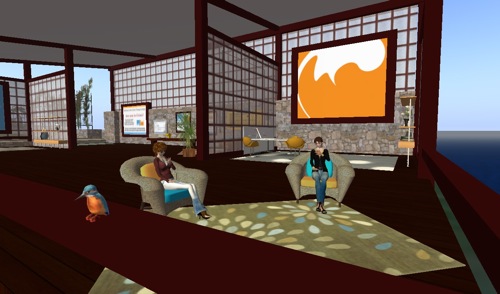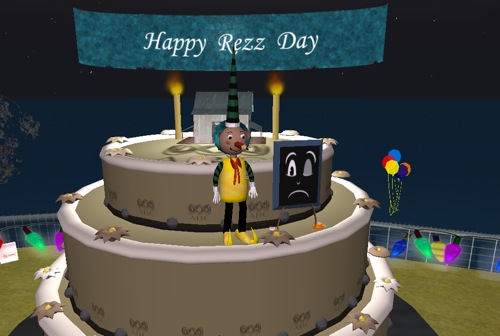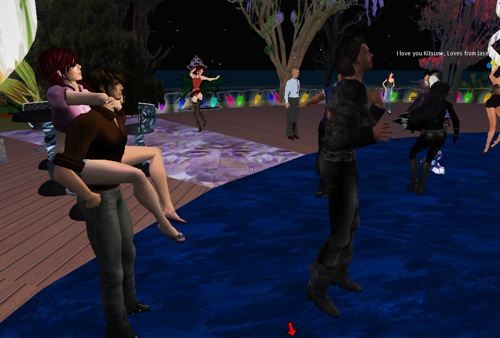 Late last year, Grossman Tucker Perreault & Pfleger announced that they had successfully registered as a trademark the multidimensional likeness of Aimee Weber, the Second Life avatar of New York content-creator and businesswoman Alyssa LaRoche.
Late last year, Grossman Tucker Perreault & Pfleger announced that they had successfully registered as a trademark the multidimensional likeness of Aimee Weber, the Second Life avatar of New York content-creator and businesswoman Alyssa LaRoche.
While GTP&P referred to it as a groundbreaking decision (it is — groundbreaking is another word for ‘first’), it is not actually an astonishing, surprising or unexpected result. It’s an obvious application of existing trademark law, in fact.
What we have here is a trademark image in a new medium, but that isn’t particularly special. At some point in the future, someone is going to trademark a projected 3D holographic logo for the first time, and that will indeed be groundbreaking, but is still an obvious extension of the trademark system into new media and expressions.
What’s interesting here is that the trademark is, essentially, a personification. LaRoche’s avatar appearance, for all intents and purposes is her, which actually makes the avatar-as-a-trademark a good deal more ordinary than a lot of the existing trademarks that have been registered.
As a random example, the US Patent and Trademark office granted trademark registration for THE FORMULAR FOR KOFI’S CONCEPT IS SIMPLE. THE PAST + THE PRESENT = THE FUTURE ALL THROUGH HISTORY IT HAS BEEN THE PAST AND THE PRESENT COMING TOGETHER TO BECOME THE NEXT BIG THING” FOR EXAMPLE NEGRO SPIRITUAL COMBINED WITH BLUES BECAME R & B ELEMENTS OF JAZZ AND BIP BOP BECAME RAP RAP COMBINED WITH OLD R & B SONGS BECAME HIP HOP NOW HIP HOP COMBINED WITH KOFI’S RECIPE = KOFRICA “THE NEXT BIG THING”®, misspelling included. Nope, we’re not kidding.
There’s literally hundreds of examples like that in the trademark database, including lengthy platitudes and sections of biblical scripture. Next to those, a 3D avatar seems positively mundane.
Benjamin Duranske, a respected commentator on law as it applies to virtual environments, said of the filing that, “McDonald’s trademarked Ronald, so there is no reason an avatar — for many users, a computer generated representation of their brand — could not also be trademarked. The rather distinct appearance of avatar ‘Aimee Weber’ is indisputably identified with the brand. And ‘Aimee Weber’ is as much a Second Life icon as she is a person you chat with at a virtual coffee shop or hire for design work; the little “TM†just makes that official.”
And LaRoche now has considerable legal leverage if someone wants to misuse her image to brand or promote unrelated products or services, or simply to mimic her for malicious purposes.
It will be interesting to see if any other people move to follow suit.
 DeeAnna: I have a Master of Education in Rehabilitation Counseling and a Bachelor of Science in Mental Health and Human Services. I have worked in the mental health field for nearly 20 years. About 10 years ago I discovered the power of the Internet and began providing online chat and email through a couple of e-clinics. Over the years I have always maintained a part-time practice online and have integrated technology in work settings working with interns, employees and clinical supervisees. I have been training therapists since 2001 about the ethical issues pertaining to technology and mental health. Now 100% of my work life is devoted to either providing online therapy or teaching others about online therapy.
DeeAnna: I have a Master of Education in Rehabilitation Counseling and a Bachelor of Science in Mental Health and Human Services. I have worked in the mental health field for nearly 20 years. About 10 years ago I discovered the power of the Internet and began providing online chat and email through a couple of e-clinics. Over the years I have always maintained a part-time practice online and have integrated technology in work settings working with interns, employees and clinical supervisees. I have been training therapists since 2001 about the ethical issues pertaining to technology and mental health. Now 100% of my work life is devoted to either providing online therapy or teaching others about online therapy. Kate Anthony: I realised this in 2001 after speaking at a conference about Telephone Helplines. The Keynote speaker was head of BTExact Technologies, and he referred to the future of virtual worlds, and avatars specifically, being part of the future of health care. Most of the audience was laughing at the concept -– I wasn’t. I went on to work with him and his team to explore the concept and write a white paper on the topic (Anthony, K. and Lawson, M (2002). The Use of Innovative Avatar and Virtual Environment Technology for Counselling and Psychotherapy. Available online at www.kateanthony.co.uk/research).
Kate Anthony: I realised this in 2001 after speaking at a conference about Telephone Helplines. The Keynote speaker was head of BTExact Technologies, and he referred to the future of virtual worlds, and avatars specifically, being part of the future of health care. Most of the audience was laughing at the concept -– I wasn’t. I went on to work with him and his team to explore the concept and write a white paper on the topic (Anthony, K. and Lawson, M (2002). The Use of Innovative Avatar and Virtual Environment Technology for Counselling and Psychotherapy. Available online at www.kateanthony.co.uk/research).


 Last week,
Last week, 




Recent Comments